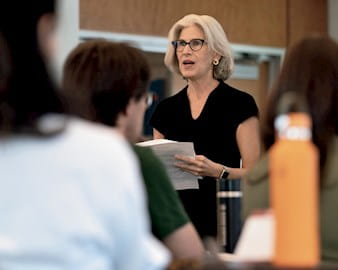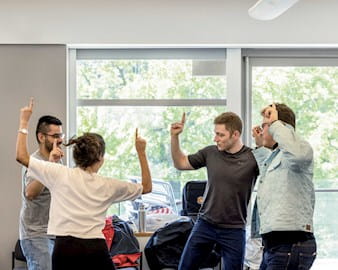The Class: Art + Business Lab
Mary Ittelson is adjunct assistant professor of strategy.
The Background
The students in my Fall Quarter Arts Leadership course, which I have been teaching for seven years, were the inspiration for this new class. Arts Leadership is about applying business principles to the strategic challenges facing museums, dance companies, theaters, and other arts organizations.
The spark came while teaching over Zoom in fall 2020—a situation that enabled me to have more guest speakers. In addition to board chairs and CEOs, I was able to have artists speak with the class. Each time, I was struck by the rapport between them and the students. The artists themselves were surprised at the depth of the conversation.
While discussing this phenomenon with colleagues, we began to wonder what might be possible if artists and MBAs worked together toward objectives beyond the typical ones. What if artists and businesspeople collaborated toward making the world a better place? Three years of research went into designing the curriculum.

We call it the Art + Business Lab, to communicate to students that we will be entering an experimental zone together—pushing against the traditional boundaries dividing the realm of entrepreneurship and innovation from that of artistic creativity. This spring we had 75 applicants for 24 slots. The students in the inaugural class proved that it is more than a utopian exercise—it’s an endeavor with real-world applications.
The Approach
The class is designed to get past stereotypes quickly. Throughout my career, first as a professional choreographer running a dance company and later as the head of a consultancy that provides strategic planning to arts and cultural organizations, I found that many artists are uncomfortable with considering themselves entrepreneurial, while many businesspeople are uncomfortable with being called a creative. But if you take off those labels, you find a lot of common ground.
To help students approach the work with open minds, the class is structured around a set of guiding principles. Exploration and discovery come first, and theory comes second. Students derive their own frameworks through in-class exercises before examining standards in the field. In addition, teaching and learning is a 50/50 proposition between students and the teaching team. Each student brings a unique perspective to the material that serves to widen the aperture for all.
The class is agnostic about for-profit versus not-for-profit. We examine best practices in both business and the arts. The interplay between disciplines is intended to open up possibilities and expand solution sets—whether the goal is to address civic problems, provide useful goods and services, or add beauty to the world.
The Case Studies
The video case studies, which form the basis of the curriculum, embody the principle that the class is a series of provocations rather than lessons to learn. Each case features an artist and a businessperson discussing their work, their aspirations, and the ways in which they might collaborate.
“The interplay between disciplines is intended to open up possibilities and expand solution sets—whether the goal is to address civic problems, provide useful goods and services, or add beauty to the world.”
— Mary Ittelson
In one, artist and University of Chicago professor Theaster Gates and investor Marty Nesbitt, ’89, have a conversation over drinks in which they generate ideas for initiatives that combine their art and business practices. In another, Lincoln Center board members team up with artists to consider ways of expanding the reach of artistic voices. In development is a third case pairing a composer of A.I.-enhanced music with a tech entrepreneur tasked with envisioning new modes of content creation and distribution.
The Classwork
As they walk in on the first day, students are handed a bag of art supplies (crayons, scissors, a glue stick) and are directed to sit at group work stations equipped with flip charts, markers, and Post-it Notes. This opening class, and each one after, begins with an artistic exercise: students create a picture or improvise a piece of music, for example, while considering and analyzing the elements of creative expression.
Next, we do exercises that explore how innovation manifests in the development of venture ideation and implementation. Finally, we examine the latest scholarship on creativity and innovation and discuss how research findings compare with our experiences.

Each week, students meet in groups to respond to assignments based on the case studies and use creative analytic techniques to devise their own new ventures. From those assignments, the groups select and build out one venture idea that they pitch in the final class to a panel of artists, businesspeople, and faculty.
The Takeaway
The ventures proposed by the inaugural class ranged from a creative-industries hub in Hyde Park to an amusement park for dogs and their owners to an arts program for under-resourced high schools.
The originality of the ideas, as well as the ingenuity of the implementation plans, demonstrated to me, yet again, that while Booth students are justifiably renowned for their quantitative skills, that is only part of the story. The class encourages students to draw upon and celebrate their broader tool kits. It provides a time and place to cultivate different modalities of thinking and acting and serves as a complement to the MBA core curriculum.
The lab’s stated fivefold goals are to help students: (1) expand their innovation and creativity practices, (2) envision new business and/or social impact ventures, (3) explore value propositions in addition to shareholder wealth, (4) develop interdisciplinary collaborative working methods, and (5) participate in foundational research. But my aspirations extend beyond those goals.
Amid the political, social, economic, and environmental turbulence of recent years, amid the big data and quantum revolutions, we need to be preparing a different caliber of leader. We want graduates who can lead without losing sight of their humanity, their values, and their compassion, and who can act with awareness of the unintended negative consequences that can result from even the best of intentions.
Art and business together will not solve the world’s problems, but the unfettered exchanges that I have seen already in the lab and the case studies point toward profound and doable initiatives, meaningful and useful ventures—tantalizing glimpses of paths toward positive change.
—Mary Ittelson
From the Students
Esther Wang, ’23
I’ve always considered myself a creative person first, and doing those classroom exercises helps break down those barriers that you define for yourself. Just because you’re in business school doesn’t mean that you’re not a creative person.
The class also helped me tap into a creative community. Many of our classes focus on quantitative measures. The value of those measures is apparent, but it’s harder to explain the intrinsic value of something more qualitative like the arts. The fact that we have a course that is dedicated to the arts and how creatives and businesspeople can interact and find synergies as opposed to working against each other has value in and of itself—and that Booth is supporting this endeavor is meaningful.
Pranav Trewn, Current Student
During one session, Professor Ittelson, who is also a dancer, led us through a dance exercise. It was valuable getting back into our bodies—most of our classes are about sitting in a room and listening. During another class, we built visual art from scratch using pipe cleaners and colorful paper. Not only does it feel really good to do something out of the ordinary, but a lot of us were surprised by how competent we were.
The lab is taught in a way that allows you to become more comfortable going out of your depth—not a lot of other courses do that. The class also serves as a reminder that we need to be learning how to work with each other and be vulnerable with each other. We tend to see business and art as oppositional forces, but we walked away from the course with a perspective on how complementary art and business actually should be.
—As told to Alina Dizik
